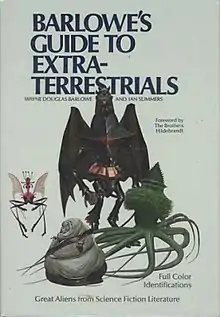Barlowe's Guide to Extraterrestrials
Barlowe's Guide to Extraterrestrials (1979; second edition 1987) is a science fiction book by artist Wayne Barlowe, with Ian Summers and Beth Meacham (who provided the text). It contains Barlowe's visualizations of different extraterrestrial life forms from various works of science fiction, with information on their planetary location or range, biology, and behaviors, in the style of a real field guide for animals. It was nominated for an American Book Award and for the 1980 Hugo Award for Best Related Work.
 Cover of the first edition | |
| Authors | Wayne Barlowe, Ian Summers, Beth Meacham |
|---|---|
| Illustrator | Wayne Barlowe |
| Cover artist | Wayne Barlowe |
| Country | United States |
| Language | English |
| Genre | Science fiction |
| Publisher | Workman Publishing Company |
Publication date | 1979 |
| Media type | Print (Hardcover and Paperback) |
| Pages | 144 |
| ISBN | 978-0894805004 |
| OCLC | 5491785 |
| LC Class | NC975.5.B36A4 |
The second edition has an added foreword by Robert Silverberg.[1]
After the success of the work, in 1996 Barlowe and Neil Duskis wrote a second book, Barlowe's Guide to Fantasy.
Summary
The book contains descriptions of the following species:
- Alternately spelled 'Sulidoror' by both Barlowe and Silverberg
Reception
Barlowe's Guide to Extraterrestrials received a mixed review from Wendy Bousfield in Library Journal. Bousfield commented that the book's drawings were "colorful", but also "somewhat static and artificial-looking, with less vitality than the preparatory sketches from the artist's notebook included at the end." She also criticized the omission of "the facts of publication of the novels", but concluded that public libraries might still be interested in the work.[3] The book received a positive review from Claudia J. Morner in School Library Journal. Morner praised the book's "colorful drawings" and "fold-out comparative size chart" showing the size of aliens relative to human beings. She concluded that it was a "fun browsing book" that would appeal to "young people fascinated by monsters" as well as to science fiction readers.[4]
Barlowe's work was nominated for an American Book Award and for the 1980 Hugo Award for Best Related Work.[5][6]
References
- Barlowe, Wayne (1987). Barlowe's Guide to Extraterrestrials. New York: Workman Publishing Company. ISBN 0-89480-500-2.
- Even though the first book of the Tripods trilogy, The White Mountains, is listed as a source, the Masters do not actually appear in it; they are revealed in the second book of the trilogy, The City of Gold and Lead.
- Bousfield, Wendy (1 January 1980). "Barlowe's Guide to Extraterrestrials (Book Review)". Library Journal: 190. – via EBSCO's Academic Search Complete (subscription required)
- Morner, Claudia J. (May 1980). "Barlowe's Guide to Extra-Terrestials (Book)". School Library Journal: 92–93. – via EBSCO's Academic Search Complete (subscription required)
- 1980 Hugo Awards Archived 2012-02-11 at the Wayback Machine
- Liptak, Andrew (2017-02-16). "Wayne Barlowe's Illustrated Aliens". Kirkus Reviews. Retrieved 2018-06-05.